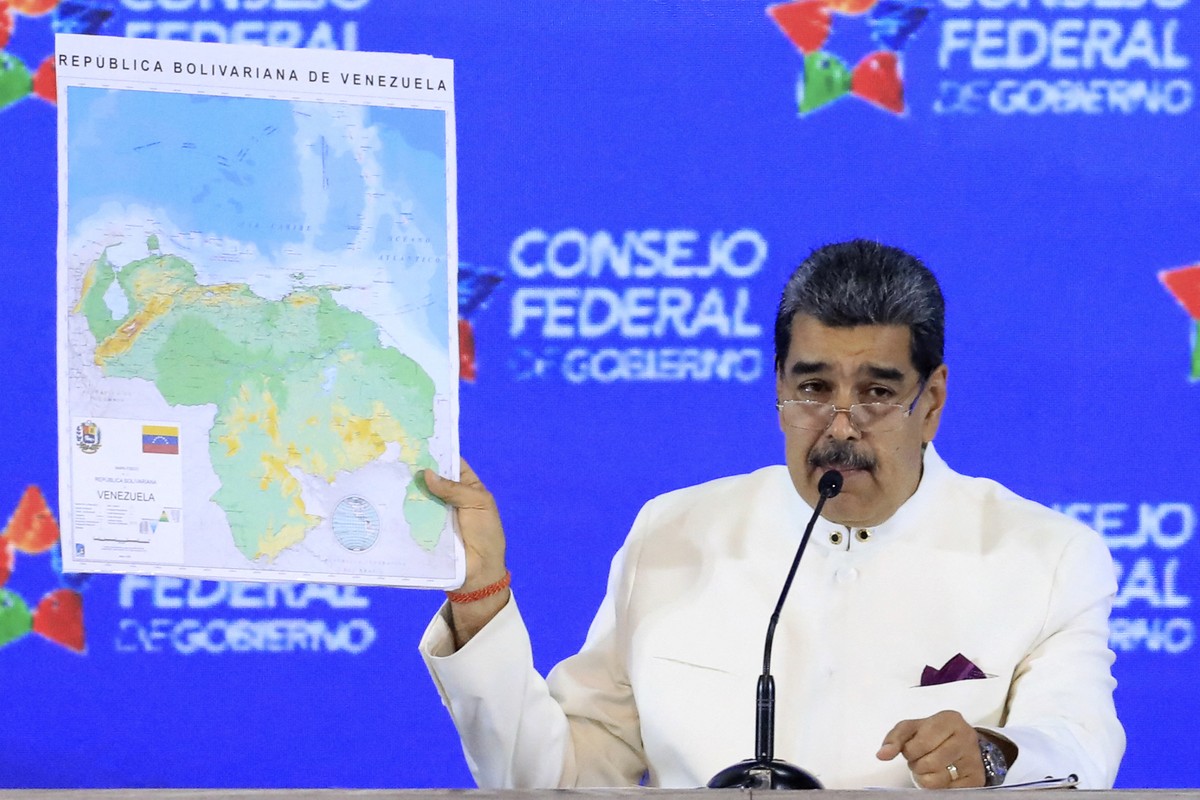1 of 3 Maduro holds a new map of Venezuela with the annexation of Essequibo Photo: Zurimar Campos/Presidency of Venezuela Maduro holds a new map of Venezuela with the annexation of Essequibo Photo: Zurimar Campos/Presidency of Venezuela
The President of Venezuela, Nicolás Maduro, published on Tuesday (5) the “new map” of the country with the incorporation of the Essequibo region. Maduro also ordered the map to be made public and distributed to educational institutions such as schools, colleges and universities.
Also on Tuesday, the President of the Venezuelan National Assembly proposed the creation of a law creating the province of “Guiana Esequiba,” annexing the territory that belongs to Guyana.
“I immediately ordered the publication and delivery of the new map of Venezuela with our Esequiba Guyana to every school, college, local council, public institution, university and every home in the country. This is our beloved card!” he published on a social network.
2 of 3 Nicolás Maduro has published a version of the new map of Venezuela on a social network Photo: Reproduction Nicolás Maduro has published a version of the new map of Venezuela on a social network Photo: Reproduction
The new version of the map has also been included in artwork illustrating Venezuelan government agencies.
In a public statement, Maduro also announced that he would order Venezuela’s state oil company PDVSA to issue licenses for oil and gas exploration in the region.
The measures announced by Venezuela come two days after the country held a referendum on the incorporation of Essequibo into Venezuela. According to the state government, 95% of voters approved the measure.
In addition to publishing the map, ordering the issuance of oil exploration licenses and proposing a law establishing a province, Maduro also proposed the following measures:
- a social assistance plan for the population of Guyana Esequiba, conducting a census and issuing identity cards to residents;
- the creation of a High Commission for the Defense of Guyana Esequiba, a body comprising the Defense Council, the Council of the Federal Government, the National Security Council and the political, religious and academic sectors;
- the creation of an integrated defense zone for Guyana Esequiba.
Venezuela x Guyana: What happens after the referendum is approved?
The Essequibo territory has been disputed by Venezuela and Guyana for more than a century. The region has been under Guyanese control since the late 19th century. The area makes up 70% of Guyana’s current territory and is home to 125,000 people.
In Venezuela the area is called Guayana Essequiba. It is a place with dense forest and in 2015, oil was discovered in the region.
It is estimated that Guyana has reserves of 11 billion barrels, most of which are offshore, near Essequibo. Due to oil, Guyana is the fastest growing South American country in recent years.
Both Guyana and Venezuela claim rights to the territory based on international documents:
- A Guyana claims to be the owner of the territory, as there is a report drawn up in Paris in 1899 that established the current boundaries. At the time, Guyana was a territory of the United Kingdom.
- Already those Venezuela declares that the territory belongs to it because this is stipulated in an agreement signed with the United Kingdom itself in 1966, before Guyana’s independence, which annuls the arbitration award and creates the basis for a negotiated solution.
The International Court of Justice ruled on Friday (1) that Venezuela cannot try to annex Essequibo and that this applies to the referendum.
Guyana had asked the court to take emergency measures to halt voting on Sunday (3) in Venezuela.
3 of 3 Infographic shows further details of the Essequibo region Photo: g1 Infographic shows further details of the Essequibo region Photo: g1

